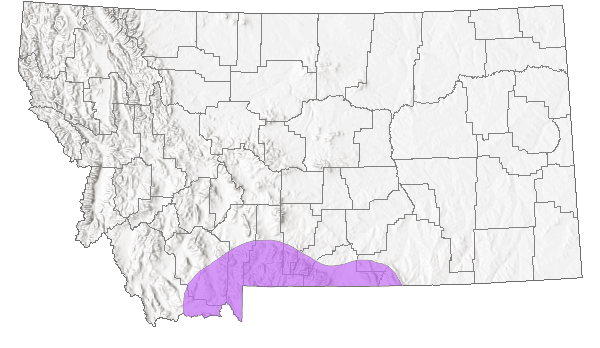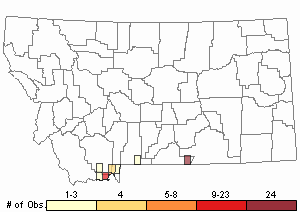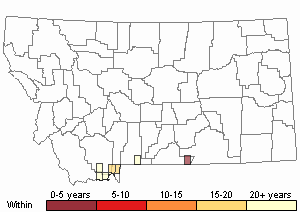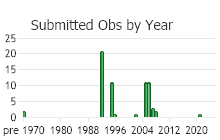View in other NatureServe Network Field Guides
NatureServe
Montana
Utah
Wyoming
Idaho
Wisconsin
British Columbia
South Carolina
Yukon
California
New York
Jove's Buttercup - Ranunculus jovis
Native Species
Global Rank:
G4
State Rank:
S4
(see State Rank Reason below)
C-value:
4
Agency Status
USFWS:
USFS:
BLM:
External Links
State Rank Reason (see State Rank above)
This species is known from several southern tier counties in Montana. Several populations have moderate to large population sizes with some of them being relatively extensive in distribution. Most known populations occur on National Forest lands. This species blooms early in the growing season (usually right after the snow melts) and as a result is probably under-surveyed. Livestock grazing occurs within some occupied habitats apparently without detrimental effects. Other impacts to populations may occur as a result of activities such as road construction or invasion of noxious weeds, however, these impacts appear to be minimal.
- Details on Status Ranking and Review
Population Size
Score0 - Large: Generally >100,000 individuals.
Range Extent
Score1 - Peripheral, Disjunct or Sporadic Distribution in MT: Widespread species that is peripheral, disjunct or sporadically distributed within MT such that it occurs in <5% of the state (<7,500 sq. miles or the combined area of Beaverhead and Ravalli Counties) or is restricted to 4-5 sub-basins.
Area of Occupancy
Score1-2 - Low to Moderate. Occurs in 4-25 Subwatersheds (6th Code HUC’s), though the species' distribution is not sufficiently documented to place it within one class.
CommentDocumented from 9 sub-watersheds and it likely occurs within additional ones.
Environmental Specificity
Score0-1 - Low to Moderate.
Trends
ScoreNA - Rank factor not assessed.
Threats
Score0 - Low: Impacts, if any, to the species are expected to be minor or insignificant (affecting <10% of populations) in severity, scope and immediacy.
CommentPotential threats are insignificant in scope/severity.
Intrinsic Vulnerability
Score0 - Low Vulnerability: Species does not have any unusual or specific life history or biological attributes or limted reproductive potential which makes it susceptible to extirpation from stochastic events or other adverse impacts to its habitat and thus slow to recover.
Raw Conservation Status Score
Score
2 to 4 total points scored out of a possible 16 (Rarity factors and threats only).
General Description
Jove's Buttercup is a glabrous perennial with 1 to several stems that are 4-10 cm tall and arising from a cluster of fleshy, club-shaped roots. The basal leaves are often lacking, but, when present, are 2-3 cm long and have a petiole and a blade that is deeply divided into 3-5 narrow lobes. The stem leaves are clustered together and are longer than the basal leaves. The yellow flowers are solitary on the ends of stalks that are 2-6 cm long. The 5 separate petals are narrowly lance-shaped and 7-12 mm long. The glabrous sepals fall off shortly after opening. The fruit is an ovoid cluster of 50-200 achenes; these egg-shaped achenes are approximately 1 mm long, slightly compressed, and finely hairy, with a straight, slender beak that is approximately 0.5 mm long.
Phenology
Flowering and fruiting April-June. Plants bloom soon after the snow melts.
Diagnostic Characteristics
This species can be distinguished from other buttercups by the clustered, fleshy roots and by the deeply 3-5 parted leaves.
Species Range
Montana Range
Range Descriptions

 Native
Native
Range Comments
Southeastern Idaho to Nevada, east to southwestern Montana, Yellowstone National Park, southwestern Wyoming, and adjacent Utah. Regional endemic.
Observations in Montana Natural Heritage Program Database
Number of Observations: 65
(Click on the following maps and charts to see full sized version)
Map Help and Descriptions
Relative Density

Recency



 (Observations spanning multiple months or years are excluded from time charts)
(Observations spanning multiple months or years are excluded from time charts)
Habitat
Sagebrush grasslands to open forest slopes in the montane and subalpine zones.
Ecology
POLLINATORS The following animal species have been reported as pollinators of this plant species or its genus where their geographic ranges overlap:
Bombus auricomus,
Bombus bifarius,
Bombus nevadensis, and
Bombus bimaculatus (Macior 1968, Thorp et al. 1983).
Stewardship Responsibility
References
- Literature Cited AboveLegend:
 View Online Publication
View Online Publication Macior, L.M. 1968. Bombus (Hymenoptera, Apidae) queen foraging in relation to vernal pollination in Wisconsin. Ecology 49:20-25.
Macior, L.M. 1968. Bombus (Hymenoptera, Apidae) queen foraging in relation to vernal pollination in Wisconsin. Ecology 49:20-25. Thorp, R.W., D.S. Horning, and L.L. Dunning. 1983. Bumble bees and cuckoo bumble bees of California (Hymenoptera: Apidae). Bulletin of the California Insect Survey 23:1-79.
Thorp, R.W., D.S. Horning, and L.L. Dunning. 1983. Bumble bees and cuckoo bumble bees of California (Hymenoptera: Apidae). Bulletin of the California Insect Survey 23:1-79.
- Additional ReferencesLegend:
 View Online Publication
View Online Publication
Do you know of a citation we're missing? Culver, D.R. 1994. Floristic analysis of the Centennial Region, Montana. M.Sc. Thesis. Montana State University, Bozeman. 199 pp.
Culver, D.R. 1994. Floristic analysis of the Centennial Region, Montana. M.Sc. Thesis. Montana State University, Bozeman. 199 pp. Lesica, P., M.T. Lavin, and P.F. Stickney. 2012. Manual of Montana Vascular Plants. Fort Worth, TX: BRIT Press. viii + 771 p.
Lesica, P., M.T. Lavin, and P.F. Stickney. 2012. Manual of Montana Vascular Plants. Fort Worth, TX: BRIT Press. viii + 771 p. Lesica, P., M.T. Lavin, and P.F. Stickney. 2022. Manual of Montana Vascular Plants, Second Edition. Fort Worth, TX: BRIT Press. viii + 779 p.
Lesica, P., M.T. Lavin, and P.F. Stickney. 2022. Manual of Montana Vascular Plants, Second Edition. Fort Worth, TX: BRIT Press. viii + 779 p. Nixon, J. 1993. Ranunculus jovis A. Nels. in Montana. Unpublished report for the Gallatin National Forest and Montana Natural Heritage Program. 13 pp.
Nixon, J. 1993. Ranunculus jovis A. Nels. in Montana. Unpublished report for the Gallatin National Forest and Montana Natural Heritage Program. 13 pp.
- Web Search Engines for Articles on "Jove's Buttercup"





